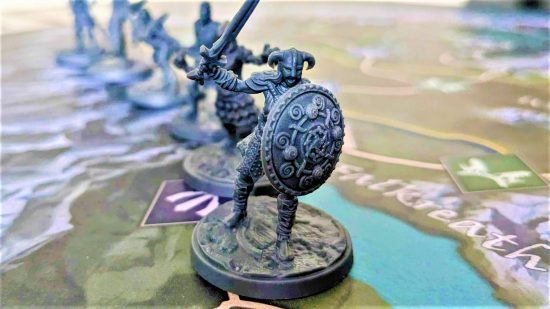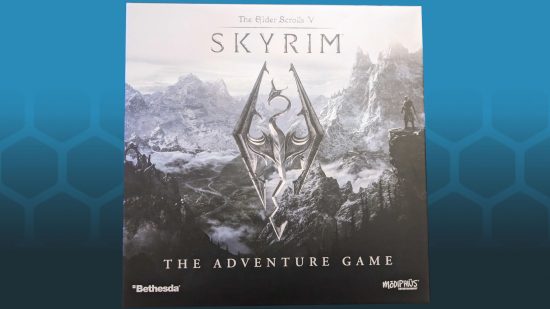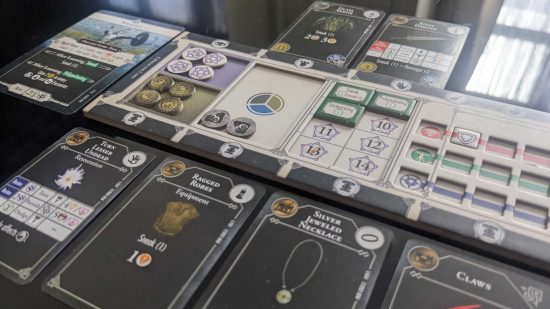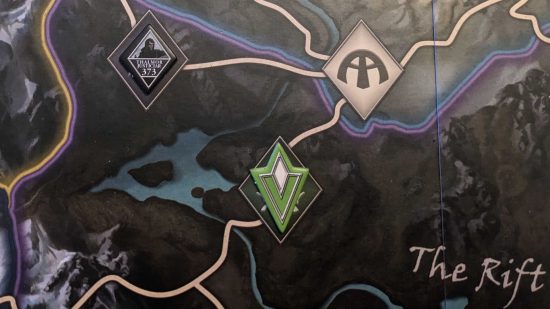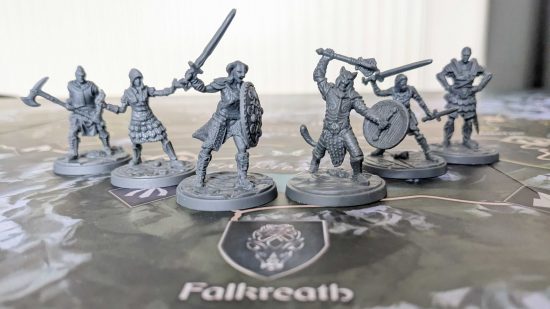Our Verdict
Without compelling writing and in-depth RPG mechanics, this adventure game feels like Skyrim in name and visual design only. Unclear rules only add frustration, further marring what could have been a light, novel campaign experience.
Considering RPG games like Skyrim have their roots in tabletop titles like D&D, you’d expect Bethesda’s most iconic fantasy videogame to be ripe for tabletop translation. Modiphius clearly agrees: after adapting Fallout and Dishonoured intro TTRPGs and wargames, the publisher has added ‘The Elder Scrolls V: Skyrim The Adventure Game’ to its list of adapted titles. It was also kind enough to send Wargamer a copy for review.
I personally find the quality of videogame board games to be hit-and-miss. Sadly, the Skyrim board game doesn’t do much to change my mind. Skyrim The Adventure Game has faithful visuals and intriguing design choices at its core, but the final result is one that lacks depth, fumbles its organisation, and also costs $140.
What is Skyrim The Adventure Game
The Elder Scrolls V: Skyrim The Adventure Game is a campaign-based adventure game for one to four players. Players control one of six heroes typical to the setting, exploring Skyrim, battling enemies, and completing various quests. You’ll gain new equipment, allies, and skills as you progress, and the game includes mechanics for trading and crafting.
There are only two campaigns in the Skyrim board game, but branching narratives and a wide range of side quests to pick up during play boost the title’s replay value. Don’t be fooled by the size of the box, though; these aren’t sprawling adventures that will take weeks to complete. Each campaign is split into three chapters, and each chapter takes a couple hours to complete at most.
The smaller scale of Skyrim will appeal to fans of dungeon-crawlers who aren’t ready to commit to a game the size of Gloomhaven. You’ll still need to pay for a game the size of Gloomhaven, though. Given the box costs $140, and the blurb on the bottom promises “hundreds of hours of gameplay”, I found myself a little disappointed the Skyrim board game didn’t have more content to offer.
What’s in Skyrim The Adventure Game
The contents of the game box also don’t seem to justify the price of Skyrim The Adventure Game. The box includes an enormous game board, smaller character boards, six plastic miniatures, various game tokens, dice, and over 800 cards. These cards cover the majority of the gameplay, featuring quests, monsters for dungeons, characters, items, upgrades, events, and rules reference cards.
The game’s contents do an excellent job faithfully recreating the look of the Skyrim videogame. However, their success is tarnished a little by one thing – inconvenience.
The board is a little too big, and most of the game’s tokens are tiny and difficult to distinguish from one another. The way the game’s cards are organised for play is one of the game’s strongest and most interesting features, but the rulebook has very little guidance on how to set them up for your first game, adding frustration to what could have been a delightful setup experience.
This isn’t the only problem with the rules, either. The rulebook (and some of the accompanying tutorial) is vaguely worded, and its overall organisation makes it difficult to navigate. There also seem to be several mistakes in the tutorial, which frequently tells you to refer to incorrect pages in the rulebook whilst learning how to play. Combine this with an extremely hands-off tutorial, and you have a rulebook that put me off playing before I’d even fully begun.
Is Skyrim The Adventure Game good or bad?
As I mentioned, the quest system is the strongest part of Skyrim The Adventure Game. Each campaign has an overarching main quest with branching options, and players can pick up personal quests through exploration or take on world quests that are open to everyone. You’re offered multi-step narratives that encourage you to explore the entire map and have meaningful consequences that impact the world and your chances of succeeding in your main quest.
Unlocking new equipment, characters, and storylines through the game’s decks is an intriguing experience, and it’s a novel way to drive gameplay. It’s just a shame the actual writing for the quest storylines is a letdown.
The game’s plot promises a prequel to the events of Skyrim that focuses on the Blades, an organisation of dragon hunters and general protectors of the land of Tamriel. I expected campaign narratives that would significantly build upon the existing world, but Skyrim the Adventure game offers thin, minimalistic writing that expects you to be content with name-drops to lore you’ll already have learned from playing the videogame. If it’s been a while since you’ve played Skyrim and you can’t really remember who the Blades are, the game isn’t going to wait around to explain it to you.
For me, several mechanics also lacked depth. The core gameplay loop, which mainly relies on rolling dice and deciding when to spend resources to improve the chances of a roll, began to feel passive and repetitive.
Some aspects of the game even seemed superfluous. I’m still not sure why certain quests have recommended levels when levelling up has no direct impact on how many dice you get to roll. A higher-level character might have picked up skills and items that make specific rolls easier, but otherwise it feels like an addition that wants to artificially extend playtime.
Speaking of levelling up, the mechanics for character builds also yield disappointment. One of the greatest parts of the Skyrim videogame is its sandbox element. Sure, you always end up playing a sneaky archer, but you could create any manner of characters with diverse talents.
The Skyrim board game injects railroading and randomness into this feature. The six playable characters have special abilities tied to skills that mean not levelling up into a specific build is a poor choice. The system for upgrading and enchanting your favourite items also relies on random card draw, meaning it’s entirely possible you’ll draw a bunch of cards that offer nothing to your intended build.
Skyrim The Adventure Board Game looks like the videogame that spawned it, but it fails to recreate the feel of the iconic RPG. Its most engaging features are seriously hindered by shallow and at-times-frustrating design.
